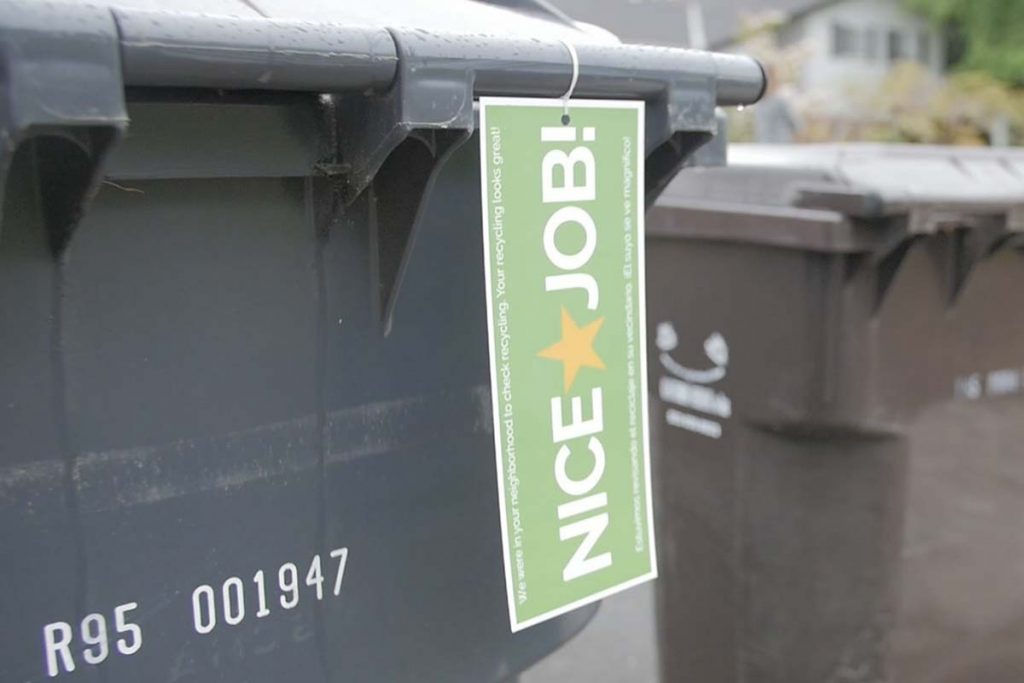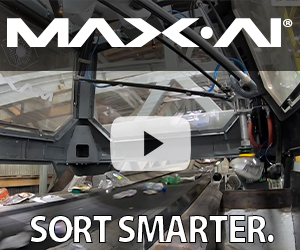
Clackamas County, Ore. was one of a number of case studies used to illustrate the data in SWANA’s report. | Clackamas Sustainability & Solid Waste Program/SWANA Report
Leaving “oops” tags on contaminated recycling carts and providing positive feedback to those with clean carts is one of the most effective ways to reduce contamination, though it can be pricey, according to a new report.
The Solid Waste Association of North America Applied Research Foundation (SWANA ARF) issued a report on the costs and effectiveness of “recycle right” educational programs. The report, “Encouraging Better Curbside Recycling Behaviors,” is a companion to an earlier SWANA ARF report released in March 2021, “Reducing Contamination in Curbside Recycling Programs.”
It includes summaries and cost analyses of The Recycling Partnership’s five recommended strategies to reduce curbside recycling contamination.
SWANA Executive Director and CEO David Biderman said the new report is a “powerful tool for local governments assessing how to improve their recycling programs and reduce contamination.”
“With the recent issuance of EPA’s National Recycling Strategy and its identification of reducing contamination as a key objective, the report is particularly timely,” he said in a press release. “SWANA will be working closely with EPA and other recycling stakeholders to implement the Strategy, using some of the lessons learned from this report.”
The five strategies are cart inspection and tagging, rejecting contaminated carts, sending direct mailers, general advertising and using social media.
SWANA ARF’s earlier report found that residents participating in curbside recycling programs can be divided into three groups: high-performers, learners and under-performers.
Over 50% of curbside contamination came from under-performers, the report said, and that group did not respond to education-only programs. The most effective way to reach under-performers was refusing to pick up contaminated carts and giving out cart contamination fines, the latest report found.
“In implementing these types of enforcement options, recycling and sustainability program managers must have the support of their local elected officials as there is likely to be pushback from under-performing residents,” the report said.
The report notes that while reliable data on the effectiveness of public outreach strategies are limited or non-existent, case studies were used to analyze each strategy.
Social media and mailers were the most effective ways to reach customers, and the least costly. The Recycling Partnership’s West Coast Contamination Initiative Research Report found that 50% of respondents in a survey of California, Oregon and Washington got their recycling program information from the internet and 10% from the cart label or mailed information.
While cart tagging is one of the most effective methods of actually reducing curbside recycling contamination, the report noted that it is labor-intensive. While costs vary by jurisdiction, the report estimates that a campaign including at least 5,000 homes ranges from $1.50 to $2.50 per household for direct engagement and mailings plus $5,000 for boosted social media and $20,000 for community signage.
However, money spent on inspecting and tagging can be recouped by the savings of lower contamination rates. In Fort Worth, Texas, the city expects to save about $475,000 per year by reducing its contamination rate from 28% to 21% through its cart inspection and tagging program, which costs $500,000 annually.
Some case studies found that carts did not necessarily need to be individually inspected and tagged to reduce contamination. Based on study findings, tagging every cart with a standard message was more effective at reducing a contaminant that is widely placed in recycling containers, like plastic bags. Direct feedback was more effective at reducing highly contaminated carts.
In 2018, in Snohomish County, Wash., Waste Management tested both generic cart tagging without cart inspection and individualized cart tagging following cart inspection to try to reduce the amount of plastic bags and bagged recyclables in recycling carts.
While the assumption at the outset of the study was that individualized cart tags would be more effective at reducing overall contamination, the study found that generic tags were actually more effective at reducing overall contamination. But if a recycling program is trying to persuade a specific household to stop putting a particular type of contaminant in the cart, then the individualized cart tags were more effective, the report found.
In Clackamas County, Ore., a six-week program in 2018 to tag clean carts with a “nice job” tag and contaminated carts with an “oops” tag improved contamination rates. Inspectors checked 11,809 set-out carts, and during the first week, only 37% got a “nice job” tag. By the sixth and final week of the study, that number had risen to 54%.
More stories about contamination
- Community Spotlight: Atlanta’s recycling still improving
- Effective resident education requires careful messaging
- Tech to spot hidden batteries draws $6.4M investment



